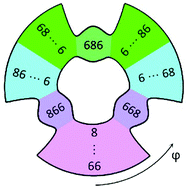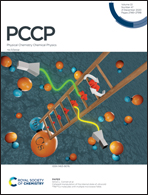Influence of the Coriolis effect on the properties of scattering resonances in symmetric and asymmetric isotopomers of ozone†
Abstract
Scattering resonances above dissociation threshold are computed for four isotopically substituted ozone species: 16O18O16O, 16O16O18O, 18O16O18O and 16O18O18O, using a variational method with accurate treatment of the rotation–vibration coupling terms (Coriolis effect) for all values of the total angular momentum J from 0 to 4. To make these calculations numerically affordable, a new approach was developed which employs one vibrational basis set optimized for a typical rotational excitation (J,Λ), to run coupled rotation–vibration calculations at several desired values of J. In order to quantify the effect of Coriolis coupling, new data are contrasted with those computed using the symmetric-top rotor approximation, where the rotation–vibration coupling terms are neglected. It is found that, overall, the major properties of scattering resonances (such as their lifetimes, the number of these states, and their cumulative partition function Q) are all influenced by the Coriolis effect and this influence grows as the angular momentum J is raised. However, it is found that the four isotopically substituted ozone molecules are affected roughly equally by the Coriolis coupling. When the ratio η of partition functions for asymmetric over symmetric ozone molecules is computed, the Coriolis effect largely cancels, and this cancelation seems to occur for all values of J. Therefore, it does not seem grounded to attribute any appreciable mass-independent symmetry-driven isotopic fractionation to the Coriolis coupling effect.

- This article is part of the themed collection: 2020 PCCP HOT Articles


 Please wait while we load your content...
Please wait while we load your content...
